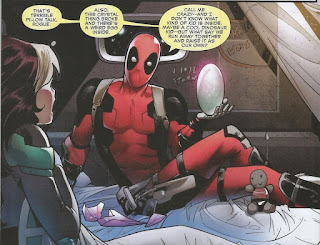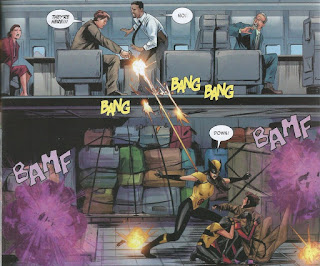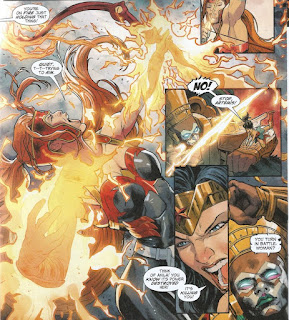Pick of the Brown Bag
August 22, 2018
by
Ray Tate
In what may be the slimmest week of the Pick of the Brown Bag, I review Mr. and Mrs. X, Scooby-Doo Team-Up and Wonder Woman but first I’ll crack open the newest version of West Coast Avengers. As always, should you not be able to relish the full POBB experience, I'm available on Twitter: #PickoftheBrownBag.
The germ of West Coast Avengers’ new formation begins when writer Kelly Thompson takes an infamous SNL sketch semi-seriously.
Although an outrageous and impossible situation, Thompson treats the premise of monstrous sharks better than The Meg did. As illustrated by Stefano Casseli the creatures look like a group of confused animals rather than menaces, and Kate Bishop a.k.a. Hawkeye handles them as such. She’s not out to kill them. She simply want to shoo them back where they belong.
Kate does pretty well alone, but she's a human archer with zero invulnerability and healing factor. I don't even think she's wearing body armor. Clearly, she's way over her head. She calls in some backup.
America Chavez, the powerhouse progeny of two moms from an alternate universe. She’s the newest version of Marvel’s Golden Age Miss America.
Fuse, the good Absorbing Man. Fuse is also Kate’s boyfriend. As far as I know, this is his first appearance. With Casseli's perfect timing, Thompson establishes him quickly. She gives him a sense of humor, makes him supportive and practical.
The team successfully leads the sharks back to the sea, with daring and comedic bravado as their momentum. Kate believes the West Coast needs protection. Hawkeye agrees, but it ain't him, babe.
With Hawkeye out of the leader position, Kate begins a superhero drive much in the same way she tried to drum up business for her fledgling private eye business.
The results are similar.
Finally, she nets somebody almost interested in joining the new West Coast Avengers.
Ms. Thompson draws upon a fiscal reality of a new superhero team not funded by Tony Stark, “the cool exec with a heart of steel.” Enter mutant jackass Quentin Quire and the crew filming him for a new reality TV show.
The reality angle allows Thompson to pull the heroes out of their present situation and plant them in front of a camera for what amounts to a confessional.
If you’ve watched reality shows, you know what this is about. I do not. Fortunately, most reality shows derive from British avatars, and I watch Doctor Who.
Thompson quickly and believably fleshes out the characters in a brevity of pages. I surprisingly know more about Quentin Quire than I should. My brief encounters with Gwenpool led me to characterize her as a saner Harley Quinn clone. Thompson strengthens this position.
Naturally, Gwen clashes strongly against Quire, and although I expected this friction, I still found it hilarious. I like the Hawkeyes. I like Gwenpool and Quentin Quire. I like America Chavez, and I like Fuse. Ultimately, none of these heroes attracted my attention.
Tigra is love.
Thompson gets her importance.
Caselli and colorist Trionna Farrell remember her lovely tail and the hue of her fur. They at once honor the bikini that Tigra used as a costume and update it in a splendid, attractive fashion.
I could not be happier with the West Coast Avengers. It kind of brings back memories of Misfits of Science, only with Tigra in it. So, it’s a million times better.
Gambit and Rogue finally got hitched courtesy of Kelly Thompson, artists Oscar Bazaldua and Frank D’Armata. If anybody would like to mention the scuzzy, slimy terrible version of Gambit, feel free to do so. He’s however in the past. This version of Gambit is actually likable and devoted. He even came up with an out of this world honeymoon.
Gambit actually suggested that he and Rogue stop having sex and do other things as a couple. He suggested she take off the suppression collar that she wore to have sex with him. This is a Gambit I only met recently in All-New Wolverine. How Gambit always should have been written.
Kitty Pryde interrupted Rogue’s and Gambit’s honeymoon to task them with a mission. Retrieve a package important to the survival of the universe. Unfortunately, the Imperial Guard hold the package.
Astra appears to be toting a M’Kraan Crystal. One of these crystals served as the nexus of reality.
Technically that fellow should have been protected by Man-Thing, but instead, the Shi’ar somehow became custodians.
Battle ensued. Rogue absorbed Astra’s phasing power. That allowed her to secure the crystal but also sent her floating out into space.
Not a cliffhanger, because against all reason, Deadpool happened to be out in space. He rescued Rogue. The crystal against all reason doubled hatched an egg.
So, this is where we find our newlyweds in issue two of Mr. and Mrs. X. In conflict against Deadpool to pilfer an egg worth millions apparently. But priceless due to the whole life or death scenario.
Our story starts with the Imperial Guard doing what the Imperial Guard do best. Suck.
Despite Gambit’s intelligently hashed out warning, the Guard chose the stupid thing. They opt to sacrifice the crystal-egg rather than capture Deadpool and Rogue.
The Guard deserve the embarrassment their other captive serves up. The abasement also humiliatingly removes them from the equation.
That leaves Deadpool. Man. Rogue was a maniacal power leech who tried to kill Captain Marvel then Ms. Marvel. Gambit, Pepe Le Pew after being drowned in raw sewage. Deadpool? That’s the last Dirty Harry movie, isn’t it? Seriously, how did I reach this point? In summary, Rom the Space Knight, Binary, Ryan Reynolds, Kelly Thompson. With an assist from Tom Taylor.
Thompson draws upon a lot of shared continuity between Deadpool, Rogue and Gambit that I really didn’t know existed. However, the beauty of Ryan Reynolds’ performance as Deadpool is that I know what the hell this guy’s about. Rogue and Deadpool were in the Avengers? Sure. Why not? Deadpool has a thing about Rogue. Pshaw. Look at her. He doesn’t like Gambit. Who does? None of this information gets in the way of the gags, the pursuit and the slapstick.
There are moments that you can hear Reynolds speaking Deadpool’s dialogue. Like when he refers to Rogue as a “daisy.” That’s just beautiful cadence.
Deadpool can heal himself rapidly like Wolverine, both of them. However, he lacks their speed and agility. Probably something to do with muscle mass. So what you get is some comedian running away slowly from a guy that that causes playing cards to chain react. It’s less Disney and more Warner Brothers. Just when you think you’ve got this whole thing diced out, Thompson throws in a surprise from across the pond.
The truce lasts until they board Gambit’s and Rogue’s ship, but Thompson isn’t about to start up hostilities again. Instead, she hits the reader with another surprise. Damn fun. I can't believe that I might be adding a Gambit and Rogue book to my subscription list.
Tom Taylor concludes the first part of X-Men Red. Jean Grey back from the dead believes that mutants and humans need to not just co-exist but respect and help each other. To that end, Jean seeks out numerous dreamers to conceive of the perfect means to see the fruition of her idea.
That solution ends up at the United Nations where she hopes mutantkind will be recognized as a nation. Jean’s aims die when a U.N. ambassador suddenly imitates Scanners.
Blamed for the assassination, Jean and a group of mutants flee. They try to discover what happened. The newest mutant Trinary reveals the gist of the game. Concocted by an old X-Men villain, nano-Sentinels exacerbate the hatred in humans and mutants alike and can even turn mutant against mutant.
With her identity revealed, the enemy now launches a two pronged desperate attack to protect her plan and eliminate Jean Grey and X-Men Red.
Namor is one of the sovereigns who vouched for Jean’s plan. Black Panther the other. Seeing her being used as a scapegoat Namor offered sanctuary from the known world.
X-Men Red began with artist Mahmud Asrar who wowed me on Dynamo 5 and Supergirl. It’s a damn shame he isn't here for the fisticuffs and gun drama, but Marvel didn’t skimp. Carmen Carnero and Rain Beredo proffer an excellent visual finish for the closer.
Taylor’s plotting is pure clockwork oiled by the characterization such as using Wolverine’s healing factor and stamina as a human shield. Her wont to protect as opposed to slice and dice like her clone source. Flipping the comedy in a reformed Sentinel to increase the danger. Wounding the person they need the most to end the crisis and a spectacular moment for Storm to atone for being used as a Manchurian Candidate. Finally, there’s the comeuppance that will keep the heat off Jean but still fan the flames of conspiracy nuts. It at once evolves a satisfying ending but not wrapped in a bow where all is solved.
What surprised me the most about Steve Orlando’s Wonder Woman is how quickly he cuts to the chase. I fully believed that this would be an issue by issue, level by level game where Wonder Woman, Artemis and the new Aztek wipe out various threats that increase with ascension. Wonder Woman is not that.
The Bronze Age Wonder Woman did this sort of thing all the time. Illustrator Aco alludes to that expressive, dare I say, comic book art style. Orlando even employs Wonder Woman’s signature call of “Hola!” Apart from Wonder Woman’s likeness to Gal Gadot, you would be hard pressed to discern the difference between Orlando’s and Aco’s current work and an issue of Wonder Woman from the seventies. That’s a high compliment.
Wonder Woman and her team encounter Tezcatlipoca on page number four, and Aco makes certain he leaves an impression.
Orlando bolsters Wonder Woman's power like nobody ever did. Aco’s artwork is nothing but pure excitement.
In case you’re wondering if Artemis and Aztek are even needed. The answer is likely no. Wonder Woman would have figured out a means to defeat the Shadow God herself. It just would have taken longer.
Once again, Orlando makes use of the continuity in Red Hood and the Outlaws. He connects Aztek’s knowledge provided by the helmet. In the end a team effort curtails this threat in an exhilarating display of art and writing.
Wacky Races didn't just entertain children. It also spawned two spin-offs.. Dastardly and Mutley and The Perils of Penelope Pitstop. It's the latter that serves as the core for a new Sholly Fisch Scooby-Doo Team-Up mystery.
For those not in the know, Penelope Pitstop is the cover girl on the train tracks. A frequent peril for the engaging Pitstop. Fisch sums up the reason for these constant dilemmas.
That's right as with most mysteries, money is the motive for all evil. Sylvester Sneekly voiced by the late, great Paul Lynde was in fact the Hooded Claw in Perils. Fisch treats this issue of Team-Up as if it were the last episode of Perils. Who better to pull off the mask than Mystery Inc?
Before all this happens, Fisch lays suspicion on the Anthill Mob, a group of seven dwarves that took part in Wacky Races as honest competitors against Penelope.
The weird thing is that Fisch is absolutely right! After a childhood of of cheering the Anthill Mob, I never realized that they're actually patterned after Robin and the Seven Hoods. Probably not the actual movie, but certainly it's title.
Jinkies! Even Shaggy and Scooby peg them. I feel utterly mortified. Because of these brilliant insights, Fisch creates rare friction between Mystery Inc. and the Mob. Subbing artist Scott Geralds does a magnificent job orchestrating the flock movement of the Anthill and their integral rescue techniques.
Rescuing the fair damsel in distress is a tradition long past its prime, but Perils was a comedy first. Penelope often rescued herself and on occasion the Anthill Mob. Fisch follows suit with inside jokes galore.
For those not in the know, Penelope Pitstop is the cover girl on the train tracks. A frequent peril for the engaging Pitstop. Fisch sums up the reason for these constant dilemmas.
That's right as with most mysteries, money is the motive for all evil. Sylvester Sneekly voiced by the late, great Paul Lynde was in fact the Hooded Claw in Perils. Fisch treats this issue of Team-Up as if it were the last episode of Perils. Who better to pull off the mask than Mystery Inc?
Before all this happens, Fisch lays suspicion on the Anthill Mob, a group of seven dwarves that took part in Wacky Races as honest competitors against Penelope.
The weird thing is that Fisch is absolutely right! After a childhood of of cheering the Anthill Mob, I never realized that they're actually patterned after Robin and the Seven Hoods. Probably not the actual movie, but certainly it's title.
Jinkies! Even Shaggy and Scooby peg them. I feel utterly mortified. Because of these brilliant insights, Fisch creates rare friction between Mystery Inc. and the Mob. Subbing artist Scott Geralds does a magnificent job orchestrating the flock movement of the Anthill and their integral rescue techniques.
Rescuing the fair damsel in distress is a tradition long past its prime, but Perils was a comedy first. Penelope often rescued herself and on occasion the Anthill Mob. Fisch follows suit with inside jokes galore.






































































































